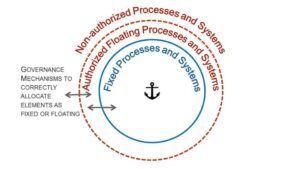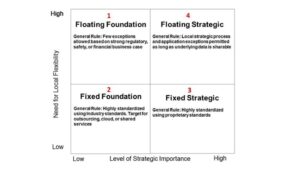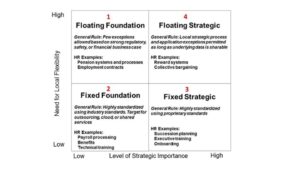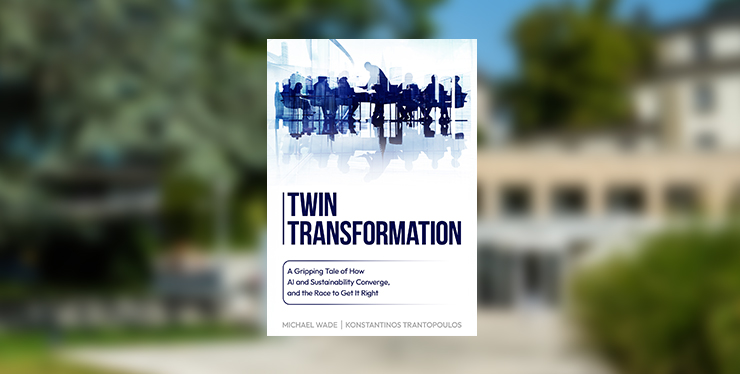
We state that we are a global company with operations in multiple countries. So, from the outside, it looks like a true multinational; but the view from the inside is less clear: We have 4 e-mail systems, 13 billing systems, each of our plants works in a different way, and we are miles away from having a single view of the customer.
Over the years, we have been told countless versions of the above story. But recently we have started to hear a new story, which goes something like this:
We have just gone through seven years of process standardization and we’ve implemented an ERP system to gain global efficiencies, but now it feels as if we have gone too far. Sure, we have a better view of the business and we have gained benefits through common processes, but we seem to have lost some of our competitive edge. We’re just not as agile or customer-oriented as we used to be.
These stories illustrate a central dilemma faced by many large organizations: How to balance local flexibility and global efficiency. Our research, which is based on interviews with senior executives at twelve multinational organizations with combined revenue of US$750 billion, has uncovered a new approach for reaching the correct equilibrium: we call it anchored agility. We will describe how some firms have achieved anchored agility by implementing strategies that are both locally agile and globally efficient.
The key to anchored agility is deciding which processes should be fixed across locations, and which ones should be allowed to float or vary depending on local needs. Achieving the optimal balance between fixed and floating systems and processes is difficult – we observed more disappointment than satisfaction. For example, a financial services firm tried to implement a standardized system of global policy production, but the regions refused to pay for the development costs because they did not consider the policies specific enough for their needs.
The five guidelines below appear to be associated with the successful organizational journey from a siloed structure to one that is globally efficient.
1. Start with processes before moving to data and IT systems
We observed a tendency to move too quickly into system implementation before fully understanding the process landscape. For example, a large shipping company lost patience with the speed of the process mapping stage of an SAP implementation and decided to overlay the software on existing processes. After seven years, the project showed few gains and the company is considering scrapping it altogether and starting afresh.
A large consumer goods company implemented an enterprise system only after clearly mapping and understanding the process landscape. A key member of the implementation team said:
We started looking at the end-to-end processes, 37 major process groups in all (e.g. order to cash). All processes were then decomposed to five levels. The fifth level showed system transactions. Levels three and four already showed how the market operated. Then we analyzed the alignment between the markets’ processes and the global best practice processes. When we identified a mismatch, we decided which to take or change.
Beyond processes, it is also critical to standardize data formats to ensure data is accessible across the organization, regardless of what systems are ultimately implemented. Data consistency was a key concern for many of the companies we
studied. The CIO of a data management company stated:
We are standardizing hardware,storage,etc.and trying to put together a framework to share data across the group. We are developing a model for publishing data so it can be leveraged across business groups. Also, we can make connections across our different domains and develop common products
2. Sequence functionally from back to front office
Another important factor is to correctly sequence organizational functions. Firms that tended to have successful outcomes began with back-office functions like accounting, finance and procurement, which are typically process driven and stand to gain most from standardization programs. Moreover, there will likely be a high proportion of fixed processes and a low proportion of floating exceptions. Customer-facing functions, including business development, marketing and sales, tend to require more floating processes and are most likely to resist change, so starting with these functions could be disastrous. Somewhere in between are supply functions such as manufacturing and logistics, which can greatly benefit from standardization but also have a moderate need for local customization.
One coffee company standardized all processes up to and including warehousing (procurement, manufacturing, etc.), leaving all processes downstream highly variable since they required a higher level of local flexibility.
3. Implement smart pilots
Some resistance is inevitable and overcoming it can be challenging, but it can be countered with pilot implementations in appropriate parts of the business, e.g. single countries or small groups of locations. Well-selected and well-conducted pilots spur strong commitment to change in managers from locations next-in-line in the rollout. If they believe in the initiative, they will be more willing to sell the change within their own organizations, resulting in full implementation of the initiative and commitment to using the new processes. But for the pilots to work, they must be:
Credible– The pilot location must have the characteristics, skills and track record to legitimize the strategic initiative. Managers will assess the pilot because the template created will become the reference point for implementation. Therefore the status or credibility of the location within the global set-up is important.
Replicable– During the pilot, the team must create a template that is rapidly transferable across locations and develop an effective transfer methodology. Managers will be scrutinizing the pilot to determine whether the product portfolio, revenues and operational set-up will allow the processes to be successfully replicated.
Feasible – The pilot has to be seen to meet the expectations of multiple stakeholders in the organization. Setting clear expectations at the start of a pilot enables stakeholders to judge its feasibility.
While the pilots yield important lessons, their fundamental objective is to gain commitment from stakeholders. According to a business unit executive within an oil and gas company:
In the first month, they expected many technical problems, but they did not experience that many… Instead, they quickly learned that no matter how much training has been given, more training is needed. Although they started training six weeks beforehand, it appeared employees had forgotten the basic steps by the rollouts. Early on they also found that design faults needed to be tracked instead of solved in silos to avoid major problems with interfaces further up or down.
4. Ensure top management support: From push to pull
Well into the efficiency journey, we observed a tipping point beyond which gains became apparent and much of the initial resistance had been overcome. We describe this as “pull.” However, first there needs to be a strong “push” from top management. All implementation successes had been strongly and visibly supported by a senior executive, often the CEO.
According to an executive of a consumer goods company that successfully implemented a multi-year, large-scale process and IT standardization project:
We started looking at the end-to-end processes, 37 major process groups in all (e.g. order to cash). All processes were then decomposed to five levels. The fifth level showed system transactions. Levels three and four already showed how the market operated. Then we analyzed the alignment between the markets’ processes and the global best practice processes. When we identified a mismatch, we decided which to take or change.
The CIO of a global flooring company echoed this view:
My predecessor didn’t want to battle regions on many of the standardization initiatives. This was fine and perhaps the right move then. But the new CEO had a vision to build a truly global company and believed this was only possible with a high degree of standardization. Since then, we have been moving ahead quickly. The CEO’s support is critical.
5. Institute strong and robust governance over time
The purpose of strong governance is threefold. First, it acts as a mechanism to determine which processes and systems should become fixed, or the global standard. Second, it facilitates identifying and authorizing floating exceptions to the standard. Strong and clear governance is critical to establish and maintain the right balance of fixed and floating elements. Third, it helps identify processes or systems that should be discontinued because they do not fit the global template.
Governance should also provide a mechanism over time for moving processes from one category to another in response to changes in the business environment. Some fixed elements might become less strategically important and can then be removed from the fixed template, while floating elements may become more strategically important over time, e.g. managing risk associated with exposure to social media might move into the fixed element set (see Figure 1).

Poor governance is dangerous: It can lead to a set of processes and systems that is too large or too small. In a large package-delivery company, poor governance led to local units with negotiated exceptions to a global HR system standardization initiative. After completing the implementation, 53 separate HR systems were still in operation across the organization!
The key to anchored agility is to find the correct mix of fixed and floating processes and systems. Too many fixed processes can inhibit local responsiveness while too many floating processes can inhibit global efficiency. Two key dimensions drive the decision on whether a system or process should be floating or fixed. These dimensions are shown in Figure 2.
The first dimension is the strategic importance of the underlying element and the second is the need for local flexibility. Processes or systems with little strategically differentiating value are candidates for rigorous standardization. Quadrant 2 contains these “fixed foundation” elements. In our experience, firms tend to underestimate the number of processes and systems that fit into this category.

Some processes with low strategic value nevertheless require local adaptation. These are part of the “floating foundation” and fall into quadrant 1. Such exceptions should be kept to a minimum as they tend to be costly, disruptive and add little in the way of organizational value.
Care should be taken with competitive differentiation elements; some need to be fixed while others should be allowed to float. Some of these processes should be made available to the whole organization but be protected from competitors through the use of proprietary standards. We refer to these as “fixed strategic” (quadrant 3). A large toy manufacturer stated: “We started by mapping core capabilities and what we wanted to protect. These were capabilities that we believe gave us a competitive advantage, e.g., key account management.” A common mistake in this category was for firms to standardize around industry best practices such as those baked into enterprise systems like SAP. These industry best practices may be effective, but they do not allow competitive differentiation because they are available to all competitors. Instead, we recommend utilizing company (not industry) best practices for strategically important activities that are relatively fixed across the enterprise.
Quadrant 4 includes “floating strategic” elements that are both strategically important and highly locally adapted. For these systems and processes, we recommend allowing local exceptions based on demonstrated need, with the caveat that the underlying data associated with these elements is in a format that is sharable with the rest of the organization. Processes and systems may vary by local unit, but the data should be accessible to all.
An illustrative example: Hire-to-retire
We illustrate how this framework can be used with an example that is core to any organization’s success: hiring and retaining talent throughout the organization. The general goal of anchored agility is to standardize as much as possible, but not at the expense of local responsiveness. Thus, an organization should start by examining hire-to-retire across the enterprise to understand how it is being done in different locations. In all likelihood, many local variations will be found. These variations will be justified by differences in local legal requirements around hiring procedures and quotas, labor rules, retirement laws and so on.
However, a careful examination will find that some processes and systems have more of a claim to local differentiation than others. We recommend using the framework presented in Figure 2 to organize these component processes into categories. The result of this analysis is shown in Figure 3. The first categorization should be into strategic and non-strategic groups, and any non-strategic processes or systems should be considered for rigorous standardization or perhaps outsourcing. Examples of non-strategic hire-to- retire processes that could be part of the fixed set include payroll processing, benefits administration and technical training. These processes and the systems that enable them can be rigorously standardized or even outsourced.
Some non-strategic hire-to-retire processes will still need to be customized due to local jurisdictional needs; these fall into the floating foundation quadrant. Examples might include pension administration systems and processes, and locally adapted clauses for employment contracts (although the general framework for the employment contract might fall into the fixed foundation quadrant). Strong governance is required to assign these sub-processes to the correct quadrants and ensure that local arguments or resistance do not push non-strategic processes into the strategic category.
Of course, some hire-to-retire processes and systems are strategic and need to be clearly recognized as such, but they should not all be treated equally. Strategic HR processes that do not need a great deal of local adaptation can be standardized, but with proprietary, company- specific standards. Processes and systems falling into this category might include executive training, succession planning and onboarding. Standardization ensures consistency across the organization, but these standards should be proprietary to build barriers to duplication and imitation. Our research revealed examples of industry standard IT systems being used for strategic and non-strategic activities.
Some hire-to-retire processes are strategic and require local adaptation. These fall into the floating strategic quadrant. Here, local exceptions are permitted as long as the underlying data is sharable. Examples within this category might include reward systems (although some aspects of rewards might be globally consistent) and collective bargaining.
Finally, in all cases, governance serves to ensure that each process and system is categorized appropriately. The governance framework should allow for movement across quadrants since some processes might become more or less strategic or require more or less local adaptation over time. For example, hiring using social media channels might begin as a floating element, an exception to the standard, but after experimentation and learning, it might become part of the fixed category. Ultimately, governing anchored agility is a dynamic journey that requires management attention.











